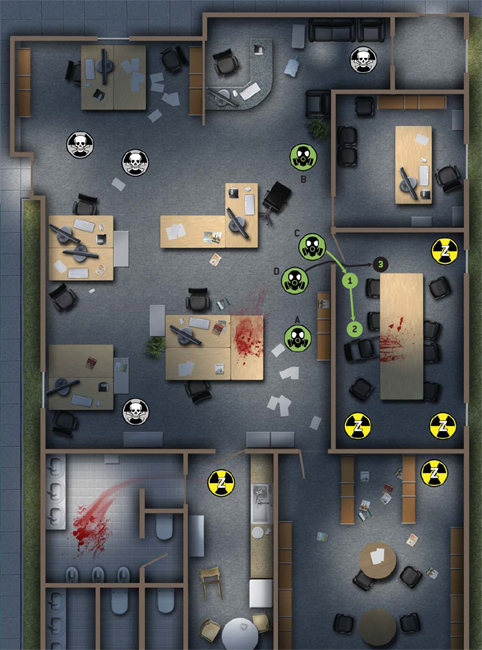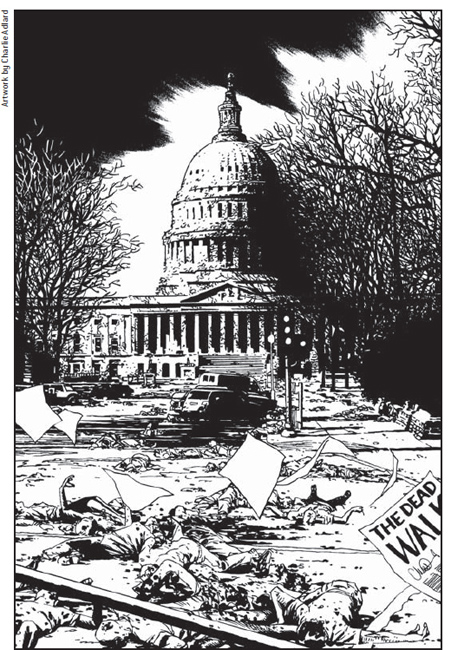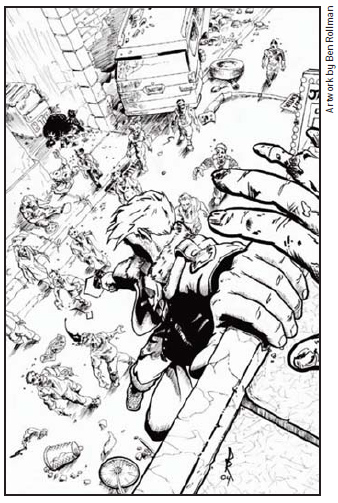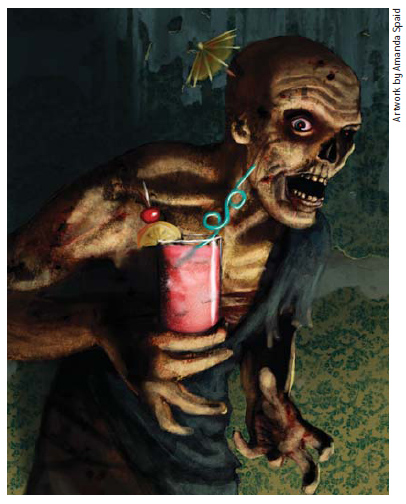Zombies (13 page)


As the containment is being established, a number of sorties are launched into the outbreak area with the purpose of bringing out survivors. Most of these sorties are conducted by individual fire teams on foot, though they remain in constant contact with ground and air transport, as either will be made available for emergency evacuation. These teams advance as far as they can into the zone, rounding up the living and escorting them back to the containment line. At all costs, the teams must avoid alerting and causing the movement of a horde toward the lines.
By the time the containment lines are fully established, the variety of zombie threat should have been determined. In the case of necromantics, the containment team will immediately go on the offensive, launching a massive attack from one side of the circle and attempting to overwhelm the horde with superior firepower. While the main attack goes straight after the zombies, a number of small teams attempt to infiltrate behind the lines in search of the necromancer. Most of the time the necromancer cannot be located and the mission becomes one messy clean-up operation.
If it is determined that the zombies are either viral or atomic, a completely different strategy is employed. Instead of going on the offensive, the containment team selects a portion of its line and reinforces it with field fortifications, claymores, and emplaced weapons, setting up a defense in depth. Once this is done, a vehicle-mounted attack element is sent into the outbreak area with the specific intent of causing a zombie horde to advance toward the fortified section of the line. By baiting the zombie horde, it can be coaxed into a kill zone and wiped out by overwhelming firepower. Once the containment team destroys the main horde, it goes on the offensive, slowly collapsing the containment circle, eliminating all zombies encountered.

Most containment teams, such as the 34th, are organized to independently cope with an outbreak in a small town or village. Should the outbreak take place in a major city, or spread throughout a whole region, obviously further military aid would be needed. In this case, the general military provides the manpower to form the containment lines, while the specialist zombie hunters run sorties and handle most of the direct combat.
To date, the battle of Mexico City remains the single largest recorded zombie outbreak since the American Civil War. This battle saw the employment of tactics similar to those described above. However, if the infection had managed to spread beyond the confines of the city, or if the number of infected had reached hundreds of thousands instead of just thousands, it is likely that such tactics would not have been effective. It remains imperative that all zombie outbreaks are contained as swiftly as possible. If the governments of the world have a plan or strategy in the event of a cataclysmic outbreak, it remains tightly under wraps. It is clear, however, that such an event would force some difficult moral decisions, that some would have to be sacrificed to save the whole. Let us pray that it never comes to that.
The following list includes many of my favorite zombie-related items. It is far from exhaustive, but should give anyone a good start on their own delving into the world of the zombie.
The Serpent and the Rainbow
&
The Passage of Darkness: The Ethnobiology of the Haitian Zombie
by Wade Davis. The premiere books about “real” zombies in Haiti.
The Zombie Survival Guide
by Max Brooks. The book that launched the current zombie publishing boom.
World War Z
by Max Brooks. A global history of a zombie “doomsday” scenario, and arguably the best zombie book ever written.
Day by Day Armageddon
by J. L. Bourne. My personal favorite first-person zombie survival story.
The Walking Dead
by Robert Kirkman, Tony Moore, and Charlie Adlard. Having already run for over seventy issues, this ongoing drama has established itself as the most successful zombie comic book to date. Thanks to the generosity of Charlie Adlard and Robert Kirkman, several pieces of artwork from this series have been reprinted in this book.
Zombies!!!
by Twilight Creations. Containing over 100 plastic zombies, this delightful little board game plays more like a video game.
Last Night on Earth, The Zombie Game
by Flying Frog Productions. Another good board game where participants can play either survivors or zombies. The game also comes with its own soundtrack!
Ambush Z
by Ambush Alley Games. A terrific wargame, focusing on military actions against the zombie threat. Probably the best game for recreating the actions of professional containment teams.
Undead States of America
. Another great wargame designed to refight zombie battles on an epic scale.
All Things Zombie
by Two Hour Wargames. Perhaps the most popular wargame rules for outbreak survivor vs. zombie confrontations.

The White Zombie
(1932). The first feature-length zombie film, starring Béla Lugosi.
Night of the Living Dead
(1968). A small-budget, independent movie directed by George Romero, it truly launched the zombie film genre and remains one of its strongest examples.
Dawn of the Dead
(1978). Romero's unconnected follow-up to
Night of the Living Dead
cemented his reputation as the greatest zombie director of all time.
28 Days Later
(2002). Revitalized the zombie genre for a new generation and brought the idea of fast-virus zombies into the mainstream.
Shaun of the Dead
(2004). Both a hilarious spoof and a good zombie movie at the same time, the movie helped open the zombie genre to a wider audience.
| Aggressor zombies | A variety of viral zombie that is faster and more aggressive than the normal viral zombie. |
| Atomic zombies | Zombies created through a chemical or radioactive contamination of a specific geographic area. |
| The Brotherhood of Death | An organization founded by Adolf Hitler after the dissolution of the Society of Thule; it included all of the foremost occultists from the old society. |
| Bureau 9 | An organization founded by Allan Pinkerton during the American Civil War to combat the zombie threat. It continues to function in that capacity even today. |
| The “Cloak Room” | A secret suite of rooms hidden beneath the British World War II codebreaking center at Bletchley Park. It served as the Headquarters for Supreme Allied Command: Shadow Theater (SAC:ST). |
| Command: The Blue Marble (C:TBM) | An organization of mercenary soldiers trained as zombie hunters. |
| Containment Teams | Specialist multinational teams within the military forces of NATO countries that can deploy quickly to suppress zombie outbreaks. |
| Division 77, “The Dirge” | Zombie-containment team of the British military. |
| Draugr | Walking corpses from Norse/Viking mythology. |
| Grimoire | A book of spells or a manual for the use of black magic. |
| The Honourable Society of the Resurrection Men | A group founded in 1756 in Edinburgh by an unknown group of body-snatchers to fight the influx of necromancers in the city. |
| Horde | Any gathering of at least ten zombies where they are grouped closely enough that each member can hear the moans of at least three other members. |
| Irradiated zombies or “rad zombies” | The walking dead that have been exposed to dangerous levels of radiation and now carry that radiation inside their lifeless shell. |
| Liche | An undead necromancer. |
| The “Moan” | A dry, warbling sound produced by some varieties of zombies that appears to be a primitive means of communication among them. |
| Necromancer | One who uses necromancy or the magic of death. |
| Necromancy | Black magic; the practice of using the dead in magical rituals. |
| Necromantic zombies | Zombies created using black magic to reanimate the bodies of the dead. |
| “Nightmen” | Nickname of the members of the US Army 34th Specialist Regiment, which specializes in zombie containment. |
| Operation Eklipse | A World War II German mission to find certain religious artifacts, with the aim of using them to facilitate the creation of zombies in far larger numbers. |
| Reaper 1 and Reaper 2 | Harvester-type vehicles created to combat large groups of zombies efficiently. |
| Revenants | A variety of zombie reawakened by a force that seems to come completely from within the deceased individual. |
| Society of Thule | A secret order founded in Munich, Germany, by a World War I veteran, devoted to the pursuit of necromantic knowledge. |
| Supreme Allied Command: Shadow Theater (SAC:ST) | A secret Allied organization formed during WorldWar II to combat the threat of the Nazi occult program. |
| Todesritter | “Death Knights” â a unit of zombie soldiers unleashed by Hitler during World War II. |
| Viral hounds | Zombie canines. |
| Viral zombies | Zombies created through a contagious virus that infects the living and turns them into zombies, following the rapid onset of death. |
| Voodoo | A magical and religious practice, often involving witchcraft and necromancy, largely centered in the islands of the Caribbean Sea |
| Voodoo zombie | A particular form of necromantic zombie created through the use of voodoo. |
| Z-virus | The virus that creates zombies. |
| The Zombie Dueling Association | An underground gladiatorial society which pits captured zombies against hired gladiators. |
| Zombie hunters | Those who hunt down and try to eliminate the threat represented by zombies. |
| Zombie master | A term once applied to necromancers who had assembled a large force of zombie minions, but has recently become more commonly associated with a zombie Typhoid Mary: a living human who carries the zombie virus and can transmit it to others without suffering its effects. |